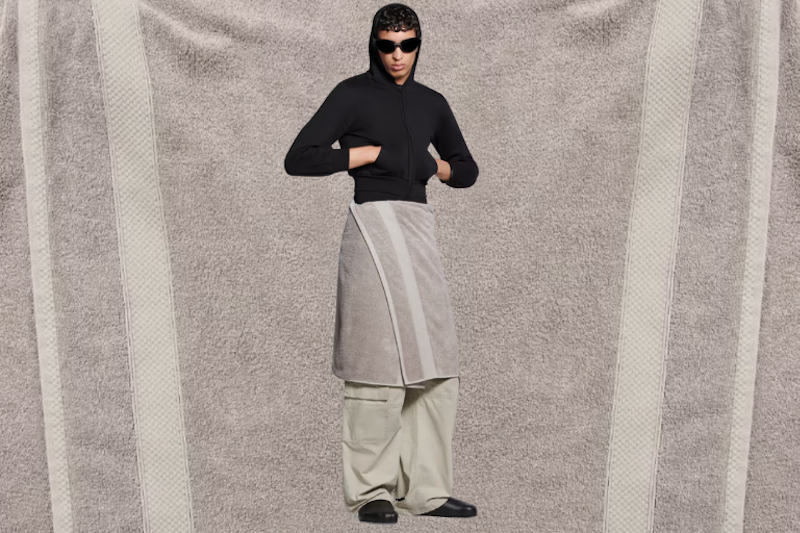A towel, a trash bag, and a pillow walk into a fashion show. Or rather, they walk in the fashion show. That's the long-running joke to which certain designers periodically return. In this joke, everyday objects—often items of household necessity—are turned into fashion, commanding not only a steep price, but a spectacle to go with them.
The “Towel Skirt” by Balenciaga is the latest in what we can rightly call "homegoodscore”—in the vein of the current predilection for naming trends a "core," or in other words, the epitome of something. For the sake of internet-age posterity, this trend should also be written as a single phrase, in all lowercase letters, just like the other “cores” (normcore, cottagecore, balletcore) identified in the Fashionista glossary. At $925, the Italian-made, 100 percent terry cotton skirt wraps around the waist exactly like a towel after one showers. It’s so convincing, that it makes you question whether to call it a skirt at all. Is it really just an actual towel held together by a small buckle, positioned inconspicuously between the folds of the fabric to make it look as if the wearer just tucked the end inside? The buckle is one of the only things that differentiate it from a towel that you could buy in Home Goods—or wherever you procure your usual tufted, water absorbing rectangular textiles—along with a "tone-on-tone" (barely visible) embroidered logo.
The “Towel Skirt” is a contradiction; a walking one, should anyone actually buy and wear it. Its design is unassuming and mundane. Yet, it's a complete spectacle. In the Debordian sense, it’s a manifestation of capitalist-driven aspirations and desires. As a meme, it's the perfect content for TikToks, Snaps, and Instagram posts crafted with society's dwindling attention spans in mind. Influencers are talking about it, and Ikea has parodied it with one of their own towels, which retails for an affordable $8. The Ikea version makes for a great dupe; the Swedish conglomerate’s towel looks similar to the French brand’s, and their model was styled and posed to jestingly imitate the Balenciaga campaign.
To create the perfect homegoodscore look, why not accessorize your “Towel Skirt” with a roll of toilet paper and some cleaning spray? Moschino’s toilet paper handbag from 2017, their Windex-inspired spray-bottle perfumes, that is. Part of what a Cosmopolitan magazine writer described as “it’s the sh*t, yo!,” the bag looks exactly as it sounds: a roll of toilet paper on a chain. Their perfumes, which have been a steady fixture on the fragrance market since 2015, look like miniature bottles of household cleaner. Last summer’s infamous Balenciaga Trash Pouch adds a finishing touch to the ensemble.
Sleep—and its symbolism—is especially prevalent, and relevant in homegoodscore. Prada is currently selling a “Padded Cotton Miniskirt” that they note was inspired by the duvet. JW Anderson’s showcased pillows sewn into shirts and held like clutches at his A/W’23 menswear show in January. People all over the world participated in the “pillow dress” challenge during the pandemic in 2020, using belts to fasten pillows-cum-dresses to their bodies. In 2005, Belgian duo Viktor and Rolf “Duvet and Pillows Dress” captured the attention of the fashion world for its trompe l’oeil effect that made it seem as if the model wearing it took her bed for a vertical walk on the runway. The reclusive designer Martin Margiela created a coat with the Italian bedding manufacturer Featherlight in 1999; one of them is in The Metropolitan Museum of Art’s permanent collection. As far back as 1973, Norma Kamali created the “Sleeping Bag Coat,” a quilted, belted piece, which she says was the first of its kind when she debuted it in 1973.
Debord surmised that “the spectacle is the nightmare of imprisoned modern society which ultimately expresses nothing more than its desire to sleep. The spectacle is the guardian of sleep.” Sleep, or ignorance, is maintained through spectacles, which are provocative events that generate surface-level conversation, not critical reflection, awareness or thinking. Spectacles are a means to create and maintain ignorance; they can be used to distract people from other more serious events, or to remain in the news cycle in the hopes of driving sales. In many cases, the latter may be true; maybe press around Prada’s duvet-like skirt is helping to once again drive conversation around a brand whose last major news was in early-October, when they announced that they’d be producing suits for future Axiom space flights. But what happens when the former is marshaled? Was Balenciaga’s bathroom clothing released in time to offset its parent company, conglomerate Kering’s controversial move of Gucci offices from Rome to Milan? Employees are currently striking, as they see the decision to be mass lay-offs, or “mass redundancy in disguise.”
Let's not forget that designers create fashion by analyzing and interpreting the zeitgeist. They react to what they’re witnessing around them and in the media. If the consumers want more leggings, they’ll make more leggings. Likewise, if they want more slumberous content—the kind that encourages either physical or mental sleep, or both— that’s what they’ll get. Those who don’t pause for critical reflection are indeed easy targets for successful ad campaigns and more.
These clothes might first give us a good laugh, eye-rolls, or double-takes. After the initial reactions subside, though, we shouldn’t hesitate to ask why they’re made.
—Doris Domoszlai-Lantner is an historian and archivist of fashion and dress. Read more about her work at www.dorisddl.com and follow her on Instagram and Twitter @doris_ddl

